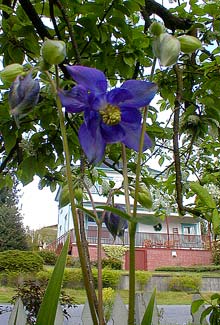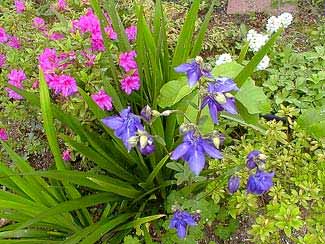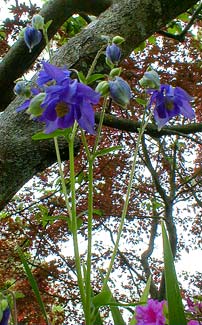
Blue
Alpine
Columbine
"Chains of columbines shall make,
For this or that occasion's sake."
-Robert Herrick
Aquilegia alpina is a species-columbine that rivals the fanciest cultivars.
It is a European native of the Swiss Alps & northern Apennines. It has been grown in American gardens since 1800, & in Europe for as long as the idea of gardening has existed.
It has ferny blue-green leaves slightly larger than most hybrids, forming a clump to a foot or eighteen inches which is shorter than many hybrids. It sends up tall, upright dark stems (to thirty inches) topped by nodding bright blue flowers.
 Some specimens have white & blue flowers, but ours has nearly pure blue blooms with stubby inch-long spurs & yellow anthers.
Some specimens have white & blue flowers, but ours has nearly pure blue blooms with stubby inch-long spurs & yellow anthers.Here on Puget Sound, the sizeable two to three inch blooms begin in April & persist through part of summer, often but not invariably with rebloom in autumn. It does not require deadheading to keep blooming.
The first photo snapped in April shows the Chokecherry's branches overhead, & our neighbor's house across the street.
The second photo snapped in May shows the blue columbine flowers amidst some white blooms of a branch of the chokecherry that dangles to the ground; the pink flowers of a 'Purple Splendor' Azalea; & sword-leaves of evergreen Stinking Iris. The third photo was also snapped earlier in May (all from 2003).
 Alpine Columbine is hardy to minus twenty degrees F., so can be grown in much harsher zones further north, where its blooming period might be more restricted to May & June.
Alpine Columbine is hardy to minus twenty degrees F., so can be grown in much harsher zones further north, where its blooming period might be more restricted to May & June.The clump will spread to two-feet width in time. It is longer lived than hybrids but will even so tire after a few years. It might be freshened by division, but will more certainly self-seed. Seedlings may sometimes turn out to be hybrids with any A. vulgaris growing nearby.
As with the A. vulgaris varieties, A. alpina wants moist semi-shady conditions. The seeds, the root & the rest of the plant contain alkaloid toxins such as magnoflorine & berberine.
Due to its toxins, it is not greatly troubled by insects & snails, & mammals such as deer are not as fond of it as they may be of other plants around it, including other species of columbine.
Drying or heating breaks down the toxins very rapidly, & there are no documented cases of death by columbine, neither of pets nor people nor livestock.
It has been used in herbal remedies, whether to any credible effect seems never to have been studied in any controled trial.
Continue to:
Columbine 'Little Lanterns'